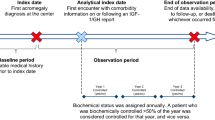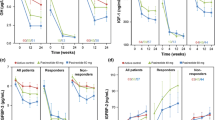Abstract
Objective: Current therapies for acromegaly are unsatisfactory for some patients. High-dose thiazolidinediones have been reported to reduce serum GH levels in animal models of acromegaly. The objective of the study was to evaluate the effect of increasing doses of rosiglitazone on serum GH and IGF-I concentrations in acromegalic patients. Design: Phase 2 clinical trial. Patients and methods: Five consecutive patients with active and uncontrolled acromegaly under conventional medical therapies were treated with increasing doses of rosiglitazone [4 mg/day every month, starting from 8 up to 20 mg/day] added to previous medical therapies for acromegaly. Results: Mean serum IGF-I concentrations decreased from 547±91 to 265±126 μg/l (p<0,001) during rosiglitazone treatment: 4 patients had normal serum IGF-I concentrations, and a patient had lowered serum IGF-I values, although still abnormal, at the end of the study. On the contrary, serum GH concentrations did not significantly changed during rosiglitazone therapy as well as other pituitary hormones. No relevant side effects of rosiglitazone were observed during the study period. Quantitative real time PCR and Western blotting showed that rosiglitazone lowered GH-dependent hepatic generation of IGF-I in HepG2 cell line. Conclusions: Rosiglitazone reduces serum IGF-I concentrations in patients with uncontrolled acromegaly under conventional medical therapies, likely actingonthe GH-dependent hepatic synthesisof IGF-I. Large studies are necessary to confirm the role of rosiglitazone as an adjunctive therapy for uncontrolled acromegalic patients under conventional medical therapies.
Similar content being viewed by others
References
Ben-Shlomo A, Melmed S. Somatostatin agonists for treatment of acromegaly. Mol Cell Endocrinol 2008, 286: 192–8.
Higham CE, Chung TT, Lawrance J, Drake WM, Trainer PJ. Long-term experience of pegvisomant therapy as a treatment for acromegaly. Clin Endocrinol (Oxf) 2009, 71: 86–91.
Colao A, Ghigo E, A.L.I.C.E. [Acromegaly primary medical treatment Learning and Improvement with Continuous Medical Education] study group. The manifesto A.L.I.C.E. (Acromegaly primary medical treatment Learning and Improvement with Continuous Medical Education) study group one year later: what to keep and what to amend? J Endocrinol Invest 2007, 30: 903–6.
Castinetti F, Morange I, Dubois N, et al. Does first-line surgery still have its place in the treatment of acromegaly? Ann Endocrinol (Paris) 2009, 70: 107–12.
Ben-Shlomo A, Melmed S Acromegaly. Endocrinol Metab Clin North Am 2008, 37: 101–22.
Colao A, Ferone D, Marzullo P, Lombardi G. Systemic complications of acromegaly: epidemiology, pathogenesis, and management. Endocr Rev 2004, 25: 102–52.
Laws ER. Surgery for acromegaly: evolution of the techniques and outcomes. Rev Endocr Metab Disord 2008, 9: 67–70.
Ciric I, Ragin A, Baumgartner C, Pierce D. Complications of transsphenoidal surgery: results of a national survey, review of the literature, and personal experience. Neurosurgery 1997, 40: 225–36.
Peacey SR, Toogood AA, Veldhuis JD, Thorner MO, Shalet SM. The relationship between 24-hour growth hormone secretion and insulin-like growth factor I in patients with successfully treated acromegaly: impact of surgery or radiotherapy. J Clin Endocrinol Metab 2001, 86: 259–66.
Castinetti F, Morange I, Dufour H, Regis J, Brue T. Radiotherapy and radiosurgery in acromegaly. Pituitary 2009, 12: 3–10.
Ayuk J, Clayton RN, Holder G, Sheppard MC, Stewart PM, Bates AS. Growth hormone and pituitary radiotherapy, but not serum insulin-like growth factor-I concentrations, predict excess mortality in patients with acromegaly. J Clin Endocrinol Metab 2004, 89: 1613–7.
Andries M, Glintborg D, Kvistborg A, Hagen C, Andersen M. A 12-month randomized crossover study on the effects of lanreotide Autogel and octreotide long-acting repeatable on GH and IGF-l in patients with acromegaly. Clin Endocrinol (Oxf) 2008, 68: 473–80.
Maiza JC, Vezzosi D, Matta M, et al. Long-term (up to 18 years) effects on GH/IGF-1 hypersecretion and tumour size of primary somatostatin analogue (SSTa) therapy in patients with GH-secreting pituitary adenoma responsive to SSTa. Clin Endocrinol (Oxf) 2007, 67: 282–9.
Murray RD, Melmed S. A critical analysis of clinically available somatostatin analog formulations for therapy of acromegaly. J Clin Endocrinol Metab 2008, 93: 2957–68.
Giustina A, Bonadonna S, Bugari G, et al. High-dose intramuscular octreotide in patients with acromegaly inadequately controlled on conventional somatostatin analogue therapy: a randomised controlled trial. Eur J Endocrinol 2009, 161: 331–8.
Trainer PJ, Drake WM, Katznelson L, et al. Treatment of acromegaly with the growth hormone-receptor antagonist pegvisomant. N Engl J Med 2000, 342: 1171–7.
Muller AF, Kopchick JJ, Flyvbjerg A, van der Lely AJ. Growth hormone receptor antagonists. J Clin Endocrinol Metab 2004, 89: 1503–11.
Schreiber I, Buchfelder M, Droste M, et al. Treatment of acromegaly with the GH receptor antagonist pegvisomant in clinical practice: safety and efficacy evaluation from the German Pegvisomant Observational Study. Eur J Endocrinol 2007, 156: 75–82.
Maffei P, Martini C, Pagano C, Sicolo N, Corbetti F. Lipohypertrophy in acromegaly induced by the new growth hormone receptor antagonist pegvisomant. Ann Intern Med 2006, 145: 310–2.
Desvergne B, Wahli W. Peroxisome proliferator-activated receptors: nuclear control of metabolism. Endocr Rev 1999, 20: 649–88.
Knouff C, Auwerx J. Peroxisome proliferator-activated receptor-gamma calls for activation in moderation: lessons from genetics and pharmacology. Endocr Rev 2004, 25: 899–918.
Emery MN, Leontiou C, Bonner SE, et al. PPAR-gamma expression in pituitary tumours and the functional activity of the glitazones: evidence that any anti-proliferative effect of the glitazones is independent of the PPAR-gamma receptor. Clin Endocrinol (OXf) 2006, 65: 389–95.
Heaney AP, Fernando M, Yong WH, Melmed S. Functional PPAR-gamma receptor is a novel therapeutic target for ACTH-secreting pituitary adenomas. Nat Med 2002, 8: 1281–7.
Occhi G, Albiger N, Berlucchi S, et al. Peroxisome proliferator-activated receptor gamma in the human pituitary gland: expression and splicing pattern in adenomas versus normal pituitary. J Neuroendocrinol 2007, 19: 552–9.
Winczyk K, Pawlikowski M. Immunohistochemical detection of PPARgamma receptors in the human pituitary adenomas: correlation with PCNA. Folia Histochem Cytobiol 2005, 43: 137–41.
Bogazzi F, Ultimieri F, Raggi F, et al. PPARgamma inhibits GH synthesis and secretion and increases apoptosis of pituitary GH-secreting adenomas. Eur J Endocrinol 2004, 150: 863–75.
Heaney AP, Fernando M, Melmed S. PPAR-gamma receptor ligands: novel therapy for pituitary adenomas. J Clin Invest 2003, 11: 1381–8.
Ambrosi B, Dall’Asta C, Cannavó S, et al. Effects of chronic administration of PPAR-gamma ligand rosiglitazone in Cushing’s disease. Eur J Endocrinol 2004, 151: 173–8.
Pecori Giraldi F, Scaroni C, Arvat E, et al. Effect of protracted treatment with rosiglitazone, a PPARgamma agonist, in patients with Cushing’s disease. Clin Endocrinol (OXf) 2006, 64: 219–24.
Suri D, Weiss RE. Effect of pioglitazone on adrenocorticotropic hormone and cortisol in Cushing’s disease. J Clin Endocrinol Metab 2005, 90: 1340–6.
Bastemir M, Akin F, Yaylali GF. The PPAR-gamma activator rosiglitazone fails to lower plasma growth hormone and insulin-like growth factor-1 levels in patients with acromegaly. Neuroendocrinology 2007, 86: 119–23.
Giustina A, Barkan A, Chanson P, et al. Guidelines for the treatment of growth hormone excess and growth hormone deficiency in adults. J Clin Invest 2008, 31: 820–38.
Bogazzi F, Lombardi M, Strata E, et al. High prevalence of cardiac hypertrophy without detectable signs of fibrosis in patients with untreated active acromegaly: an in vivo study using magnetic resonance imaging. Clin Endocrinol 2008, 68: 361–8.
Bogazzi F, Ultimieri F, Raggi F, et al. Growth hormone inhibits apoptosis in human colonic colon cancer cell lines: antagonistic effects of peroxisome proliferator activated receptor-gamma ligands. Endocrinology 2004, 145: 3353–62
Lecka-Czernik B, Ackert-Bicknell C, Adamo ML, et al. Activation of peroxisome proliferator-activated receptor γ (PPARγ) by rosiglitazone suppresses components of the insulin-like growth factor regulatory system in vitro and in vivo. Endocrinology 2007, 148: 903–11.
Clemmons DR, Underwood LE, Ridgway EC, Kliman B, Kjellberg RN, Van Wyk JJ. Estradiol treatment of acromegaly. Reduction of immunoreactive somatomedin-C and improvement in metabolic status. Am J Med 1980, 69: 571–5.
Attanasio R, Barausse M, Cozzi R. Raloxifene lowers IGF-1 levels in acromegalic women. Eur J Endocrinol 2003, 148: 443–8.
Chiquette E, Ramirez G, DeFronzo R. A meta-analysis comparing the effect of thiazolidinediones on cardiovascular risk factors. Arch Intern Med 2004, 164: 2097–104.
Meisner F, Walcher D, Gizard F, et al. Effect of rosiglitazone treatment on plaque inflammation and collagen content in nodiabetic patients. Data from a randomized placebo-controlled trial. Arterioscler Thromb Vasc Biol 2006, 26: 845–50.
Nissen SE, Wolski K. Effect of rosiglitazone on the risk of myocardial infarction and death from cardiovascular causes. N Engl J Med 2007, 356: 2457–71.
Murlow CD, Cornell JE, Localio AR. Rosiglitazone: a thunderstorm from scarce and fragile data. Ann Intern Med 2007, 147: 585–7.
Bihan H, Espinosa C, Valdes-Socin H et al. Long-term outcome of patients with acromegaly and congestive heart failure. J Clin Endocrinol Metab 2004, 89: 5308–13.
Colao A, Marzullo P, Lombardi G. Effect of a six-month treatment with lanreotide on cardiovascular risk factors and arterial intima-media thickness in patients with acromegaly. Eur J Endocrinol 2002, 146: 303–9.
Bogazzi F, Battolla L, Spinelli C, et al. Risk factors for development of coronary heart disease in patients with acromegaly: a five-year prospective study. J Clin Endocrinol Metab 2007, 92: 4271–7.
Author information
Authors and Affiliations
Corresponding author
Rights and permissions
About this article
Cite this article
Bogazzi, F., Rossi, G., Lombardi, M. et al. Effectofrosiglitazoneonserum IGF-I concentrations in uncontrolled acromegalic patients under conventional medical therapy: Results froma pilot phase 2 study. J Endocrinol Invest 34, e43–e51 (2011). https://doi.org/10.1007/BF03347060
Accepted:
Published:
Issue Date:
DOI: https://doi.org/10.1007/BF03347060




